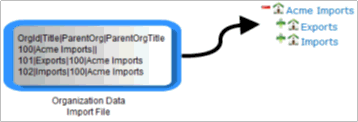Global AlertLink allows for several types of data to be imported into the system through a flexible and dynamic import system. Global AlertLink can support one-time/initial data loads, as well as ongoing data maintenance. The Global AlertLink implementation team will work with you to implement your data management process. Data can be managed in an external system, and imported into Global AlertLink on an ongoing basis, users can maintain their data directly in Global AlertLink through the easy to use web interface, or you can implement a hybrid scenario maintaining some data externally and some using the web interface.

Hierarchy Management
The import process can automatically define the system hierarchy. By including organization and folder information in the data import files, the import process will automatically create system hierarchy and folder structure to contain the data.
Frequency
Data imports can be scheduled to occur based on your need. Most customers provide a nightly or weekly data feed to maintain the data within Global AlertLink. Additionally, some customers import data on an as needed basis, and initiate manual data feeds as necessary.
File Transfer Methods
Files may be “pushed” to the Global AlertLink server, or we can “get” files from your server. “Pushing” files provides the greatest control, and allows you the flexibility to perform ad-hoc updates when needed. We support both the FTP and SFTP protocols for file transfers. Your implementation manager will work with you during the implementation phase to configure one or both of these options.
Folders
Global AlertLink provides a set of sub-folders for customers utilizing FTP or SFTP to transfer files into. Note that these folders are configured for, and represent individual data import jobs. Your implementation manager will work with you to identify the correct folder for each data import job.
Scheduling
Data imports are automatically processed when received by the Global AlertLink server. Typical data imports have little or no impact on system performance. However, we recommend customers schedule data feeds to occur at a time that will have the least impact on system usage. For domestic customers, we recommend early morning (12:00am – 3:00am) data feeds. For international customers, or customers with multiple locations, we recommend scheduling the data feed during an off-peak time for the end users of the system.


